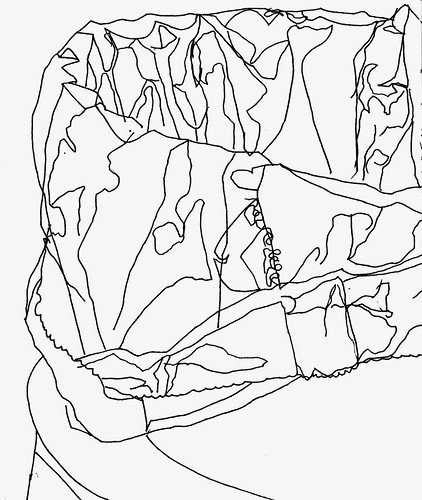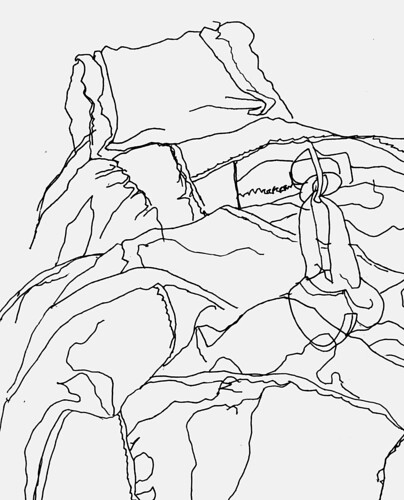Place the point of your pencil on the paper. Imagine that your pencil point is touching the model instead of the paper. Without taking your eyes off the model, wait until you are convinced that the pencil is touching that point on the model upon which your eyes are fastened. Then move your eye slowly along the contour of the model and move the pencil slowly along the paper. As you do this, keep the conviction that the pencil point is actually touching the contour. Be guided more by the sense of touch than by sight.
—Kimon Nicolaides, The Natural Way to Draw
In the first week of Drawing Machines with David Nolen we’ve been exploring line and contour through drawing studies, photographs,and readings. The approach has centered on the first exercise in Kimon Nicolaides instructional masterpiece, The Natural Way to Draw (the key moment of which, I’ve reproduced above).
Most Western art discourse about line either valorizes it as the sign of ‘true thought’ (i.e. Poussin) or dismisses it as ‘mere design’ (i.e. Greenberg). Nicolaides, on the other hand, connects line to touch and hence to a profoundly concrete and physical experience of objects. In order to create a contour drawing to Nicolaides’ formula, you have to induce a kind of synesthetic mix-up between your eye and the tip of your finger, caressing the first along an object as if it were the second, while passively tracing that movement with your pencil.
The drawings produced with this approach (or at least mine) tend to resemble landscapes no matter their subject. It’s as if I, and hence the viewer, has been reduced to the miniature scale of that pencil tip/eye point and sent to wander the mountainous peaks and valleys of the trash can or backpack or pile of clothes.
Strangely and coincidentally, much of my undergraduate art education was based on Nicolaides’ curriculum — and especially this approach to contour drawing. At Reed, Michael Knutson lead us through the lessons in The Natural Way to Draw without naming them as such. However, I’d come across the book during attempts to teach myself drawing from the local Barnes and Noble art shelf and so immediately recognized them.
Where does the contour drawing naturally end? Reaching the end of one line, you pick your pencil up and see the next one attach itself. Your touch brings each edge of each object equally close to your eye, creating a flat field that threatens to stretch off infinitely in every direction. The tree trunk three yards beyond the trash can, shrunken and forced back by old two-eyed perspective, is hauled up close into the can’s plane, pushing out of its existing lines, pulling your jointly single eye/hand into it. And, in its slavish tracing, the drawing pays no attention to composition — the usual tyranny the edge of the page imposes on what to include and at what scale. Instead, the contour-tied hand chases the eye through the unlimited, uncomposed, unending space. The result is that each drawing feels like a fragment torn free from some coherent fabric that covers the extent of the visible world, like Borges’ Empire of Cartography that “struck a Map of the Empire whose size was that of the Empire, and which coincided point for point with it” (On Exactitude in Science). Each real drawing is nothing more than a “Tattered Ruin of that Map, inhabited by Animals and Beggars.”



